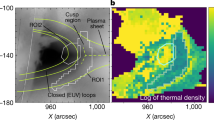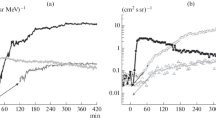Abstract
It has previously been suggested that the very high relative abundances of helium occasionally observed in the solar wind mark the plasma accelerated by major solar flares. To confirm this hypothesis, we have studied the 43 spectra with He/H ⩾ 15% that were observed among 10300 spectra collected by Vela 3 between July 1965–July 1967. The 43 spectra were distributed among 16 distinct periods of helium enhancement, 12 of which (containing 75% of the spectra) were associated with solar flares. Six new flare-enhancement events are discussed in this paper. It is concluded that the association of helium enhancements with major flares is real, non-random and very strong.
With this study, there are 12 cases of reliable associations between helium enhancements (He/H ⩾ 15%) and flares reported in the literature. The general characteristics of these events are discussed. It is found that the flares are typically large and bright (2B or 3B), often they produce cosmic ray protons, and they are widely distributed in solar longitude. The average transit velocity of the pistons (i.e., flare accelerated driver gas) is in excellent agreement with earlier observations of flare shock velocities. The degree to which the pistons have been slowed in transit is in good agreement with theory. The average percentage of helium in the enhanced regions is 15%, but this number should not be considered more than an extremely rough estimate because of very arbitrary decisions that had to be made as to when we would consider an ‘enhancement’ had ended. The number of positively charged particles in the enhanced region is estimated to be of the order of 4 × 1039.
A qualitative discussion of some of the possibilities for the source of helium enhanced plasma is presented. It is suggested that the helium enriched plasma may be the piston producing the shock causing the Type II radio emission. The size of the Type II emission region and the number of particles in the helium enhancement permit an estimate to be made of the density of the corona at the origin of the piston. From this it is estimated further that the piston must come from below about 0.5 R ⊙, in agreement with the 0.2–0.3 R ⊙ often given for the initial height of the Type II emission source. Recent theoretical discussions have indicated that the corona as a whole can be expected to show helium enrichments at these levels.
It is pointed out that observations of solar wind helium enhancement can be expected to be a useful tool in studying the distribution and relative abundance of helium in different layers of the solar corona, as well as mechanisms for the acceleration of plasma by solar flares.
Similar content being viewed by others
References
Alloucherie, Y.: 1970, J. Geophys. Res. 75, 6899.
Bame, S. J., Asbridge, J. R., Hundhausen, A. J., and Strong, I. B.: 1968, J. Geophys. Res. 73, 5761.
Billings, Donald E.: 1966, A Guide to the Solar Corona, Academic Press, New York.
Brandt, John C.: 1966, Astrophys. J. 143, 265.
Delache, P.: 1967, Ann Astrophys. 30, 827.
De Young, D. S. and Hundhausen, A. J.: 1971, J. Geophys. Res. 71, 2245
Dryer, Murray: 1972, Proceedings of the Conference on the Solar Wind, Asilomar, Calif., 21–26 March, 1971, to be published.
Formisano, V., Palmiotto, F., and Moreno, G.: 1970, Solar Phys. 15, 479.
Geiss, J., Hirt, P. and Leutwyler, H.: 1970, Solar Phys. 12, 458.
Hirshberg, J.: 1968, Planetary Space Sci. 16, 309.
Hirshberg, J., Alksne, A., Colburn, D. S., Bame, S. J., and Hundhausen, A. J.: 1970, J. Geophys. Res. 75, 1.
Hirshberg, J., Asbridge, J. R., and Robbins, D. E.: 1971, Solar Phys. 18, 313.
Hundhausen, A. J.: 1970, Rev. Geophys. and Space Phys. 8, 729.
Hundhausen, A. J. and Gentry, R. A.: 1969, J. Geophys. Res 74, 2908.
Hundhausen, A. J., Asbridge, J. R., Bame, S. J., Gilbert, H. E., and Strong, I. B.: 1967, J. Geophys. Res. 72, 87.
Hundhausen, A. J., Bame, S. J., and Montgomery, M. D.: 1970a, J. Geophys. Res. 75, 4631.
Hundhausen, A. J., Bame, S. J., Asbridge, J. R., and Sydoriak, S. J.: 1970b, J. Geophys. Res. 75, 4643.
Jokippi, J. R.: 1966, in R. J. Mackin, Jr., and M. Neugebauer (eds.), The Solar Wind, Pergamon Press, N.Y.
Kane, S. R., Winckler, J. R., and Hofmann, D. J.: 1968, Planetary Space Sci. 16, 1381.
Kuckes, A. F. and Sudan, R. N.: 1971, Solar Phys. 17, 194.
Kundu, Mukul R.: 1965, Solar Radio Astronomy, John Wiley and Sons, Inc.
Lanzerotti, L. J. and Robbins, M. F.: 1969, Solar Phys. 10, 212.
Lazarus, A. J. and Binsack, J. H.: 1969, Ann. I.Q.S.Y. 3, 378.
Lin, R. P.: 1970, Solar Phys. 12, 266.
Nakada, M. P.: 1969, Solar Phys. 7, 302.
Nakada, M. P.: 1970, Solar Phys. 14, 457.
Neugebauer, M. and Snyder, C. W.: 1966, in R. J. Mackin and M. Neugebauer (eds.), The Solar Wind, Pergamon Press, N.Y.
Newkirk, G.: 1967, Ann. Rev. Astron. Astrophys. 5, 213.
Ogilvie, Keith W., Burlaga, L. F., and Wilkerson, T. D.: 1968, J. Geophys. Res. 73, 6809.
Ogilvie, K. W. and Wilkerson, T. D.: 1969, Solar Phys. 8, 435.
Parker, E. N.: 1963, Interplanetary Dynamical Processes, Interscience Publishers, N.Y.
Robbins, D. E., Hundhausen, A. J., and Bame, S. J.: 1970, J. Geophys. Res. Space Phys. 75, 1178.
Švestka, Z. and Simon, P.: 1969, Solar Phys. 10, 3.
Sweet, P. A.: 1969, Ann. Rev. Astron. Astrophys. 7, 149.
Taylor, Harold E.: 1969, Solar Phys. 6, 320.
Valdez, Jesusa and Altschuler, Martin D.: 1970, Solar Phys. 15, 446.
Vernov, S. N., Lyubimov, G. P., Kontor, N. N., Pereslegina, N. V., and Chuchkov, V. A.: 1970, Preprint, Moscow State University.
Wolfe, J. H., Silva, R. W., McKibbin, D. D., and Mason, R. H.: 1966, J. Geophys. Res. 71, 3329.
Wilcox, John M. and Ness, Norman F.: 1965, J. Geophys. Res. 70, 5793.
Wild, J. P., Smerd, S. F., and Weiss, A. A.: 1963, Ann. Rev. Astron. Astrophys. 1, 291.
Yeh, Tyan: 1970, Space Sci. 18, 199.
Author information
Authors and Affiliations
Rights and permissions
About this article
Cite this article
Hirshberg, J., Bame, S.J. & Robbins, D.E. Solar flares and solar wind helium enrichments: July 1965–July 1967. Sol Phys 23, 467–486 (1972). https://doi.org/10.1007/BF00148109
Received:
Issue Date:
DOI: https://doi.org/10.1007/BF00148109




